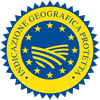Description
The Tarta de Santiago PGI is a traditional cake from Galicia, with first quality almonds from the Comuna, Marcona, Mollar, Largueta and Planeta Mediterranean varieties, extra white sugar, eggs, grated lemon peel, iced sugar and sweet wine, brandy or marc brandy. In the case of Tarta de Santiago PGI, including the covering bottom, the covering layers have to weigh maximum 25% of its total weight. The layers can consist either of filo pastry, made with hard wheat flour, butter, water and salt, or of short-crust pastry or flaky pastry made with wheat flour, butter, extra white sugar, eggs, milk and salt.
Production Area
The production area of Tarta de Santiago PGI covers the entire Autonomous Community of Galicia.
Production Method
Tarta de Santiago PGI is cooked using the traditional recipe which is recognised in the production area. The conditioning, which is considered a fundamental part of the preparation, has to take place in the production factory to guarantee that the product's fragility will not compromise its right conservation. The packaging used has to be made in suitable materials to guarantee the conservation of the product during transport and has to be new and clean. A seal or a counter-label has to be applied on packaging, with the alphanumeric code and the related authorised number.
Appearance and Flavour
Tarta de Santiago PGI has a round shape and the surface is white in colour due to the covering of iced sugar. As a sign of identification, the Cross of the Order of Santiago is reproduced on the surface. The dough is gold in colour and features a porous and granular consistency. It features a typical almond flavour, with a recognisable taste of almond and egg.
History
Tarta de Santiago PGI boasts very ancient origins. The first evidence of the preparation and consumption of the cake today known as Tarta de Santiago goes back to 1577, on occasion of the visit and studies of D. Pedro de Portocarrero in the University of Santiago. The first recipes go back to a later period, in fact, they can be found in the Cuaderno de confiteria by Luis Bartolomé de Leybar, dated back to 1838, and in the book El confitero y el pastelero by Eduardo Merín. However, the product was not mentioned in Spanish recipe books before the 20th century, therefore it was considered a regional speciality. Today, Tarta de Santiago PGI continues to be prepared basing on recipes which date back at least to the 19th century. The Cross of Santiago decorated on the cake surface is due to the founder of the Casa Mora of Compostela, who added it in1924 and then was followed by many other Galician producers. In 1996, the Tarta de Santiago can be found amongst the products in the Spanish inventory of traditional products published by the Ministry of agriculture, fishing and food, where the Galician origin of this product is underlined.
Gastronomy
Tarta de Santiago PGI preserves its softness and fragrance if stored in a fresh and dry room. It is ideal when consumed at the end of a meal or accompanied with tea, coffee or sweet wines. Very good also for breakfast or as a snack.
Marketing
The product is sold as Tarta de Santiago PGI with or without covering bottom. It is sold in different formats depending on the dimensions and packed in specific packaging for every piece made in a suitable material for the conservation and transport.
Distinctive Features
The almond-based products, which at the beginning were used by the healthier classes, registered a widespread up to be integrated in the local cuisine, despite the scarce amount of almonds that can be found in the area. Among them, Tarta de Santiago PGI differentiates from the others due to its look and its organoleptic qualities which give the product a peculiar taste and consistency.






